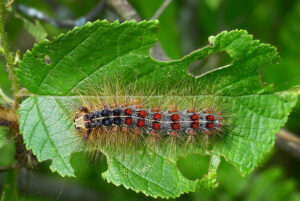By Bill McNee, Forest Health Specialist, Oshkosh
bill.mcnee@wisconsin.gov or 920-360-0942

Mature spongy moth caterpillar on a leaf. Photo: Bill McNee, Wisconsin DNR
Wisconsin Department of Natural Resources Forest Health staff are cautioning Wisconsin residents that the next two months could bring the worst spongy moth outbreak in more than a decade.
The caterpillars of this invasive insect prefer to feed on oak, birch, crabapple, aspen and willow leaves, but will also feed on many other tree and shrub species.
Southern Wisconsin and parts of the north are already in a high-population outbreak that is predicted to continue and spread. Populations have remained high due to a low incidence of caterpillar-killing diseases last summer. In addition, weather conditions in 2023 are favorable for the caterpillars and unfavorable for Entomophaga maimaiga, a fungus that kills spongy moth caterpillars.
Property owners are encouraged to examine their trees and take action. Specifically:
- Visit wi.gov for information about managing spongy moth. Management options include burlap collection bands, physically destroying caterpillars and applying insecticide to protect trees. Last month’s Forest Health Newsletter article also provides relevant information.
- Watch this video showing how to use a burlap collection band to catch and kill spongy moth caterpillars.
- Insecticide treatments can be a suitable option for high-value host trees but are not practical for woodlots.
- Water yard trees weekly during dry periods to help reduce tree stress and aid a tree’s recovery from heavy defoliation.
- Avoid touching the hairy caterpillars, as well as the moths and egg masses that will appear later in the summer. The hairs often cause a skin rash, welt, or other irritation. Rubbing alcohol can help to remove the hairs and chemical irritants from skin that is exposed to the hairs.
- Wait to cut down any trees that are defoliated. Healthy hardwood trees usually produce a new set of leaves a few weeks later.
- Forest management may need to be postponed in areas that are defoliated. Trees will be stressed from heavy defoliation and will often be unable to handle the additional stress from forest thinning.
Arrange for insecticide treatments ahead of time to help secure an applicator and avoid a last-minute rush when pesticide application businesses may already be very busy. Resources for finding a qualified pesticide applicator include the Wisconsin Arborist Association, International Society of Arboriculture and a local telephone directory.
Stressed trees are already at an elevated risk of mortality and will often die if defoliated in 2023. Low-vigor oak trees are likely to be infested by a native beetle, the twolined chestnut borer, contributing to tree decline and mortality. Consult an arborist or forester for additional management recommendations.
Many areas currently experiencing a second or third year of the spongy moth outbreak are likely to have a population decline or collapse due to diseases or starvation. Where and when this may happen is difficult to predict, and heavy defoliation often occurs before the caterpillar population collapses.
